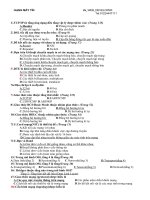mạng máy tính phạm trần vũ bài giảng 6 network layer (cont )
Bạn đang xem bản rút gọn của tài liệu. Xem và tải ngay bản đầy đủ của tài liệu tại đây (3.39 MB, 43 trang )
Computer Networks 1
(Mạng Máy Tính 1)
Lectured by: Dr. Phạm Trần Vũ
1
SinhVienZone.com
/>
Lecture 5: Network Layer (cont’)
Reference:
Chapter 5 - “Computer Networks”,
Andrew S. Tanenbaum, 4th Edition, Prentice Hall, 2003.
2
SinhVienZone.com
/>
Contents
The network layer design issues
Routing algorithms
Congestion control algorithms
Quality of services
Internetworking
The network layer in the Internet
3
SinhVienZone.com
/>
Congestion Control Algorithms
•
General Principles of Congestion Control
•
Congestion Prevention Policies
•
Congestion Control in Virtual-Circuit Subnets
•
Congestion Control in Datagram Subnets
•
Load Shedding
•
Jitter Control
4
SinhVienZone.com
/>
Network Congestion
When too much traffic is offered, congestion sets
in and performance degrades sharply.
5
SinhVienZone.com
/>
General Principles of Congestion
Control
Open loop solutions
Solve the problems by good design
Prevent congestions from happening
Make decision without regard to state of the
network
Closed loop solutions
Using feedback loop
6
SinhVienZone.com
/>
Closed Loop Solutions –
Three Part Feedback Loop
Monitor the system
detect when and where congestion occurs.
Pass information to where action can be
taken.
Adjust system operation to correct the
problem.
7
SinhVienZone.com
/>
Open Loop Solutions - Congestion
Prevention Policies
Policies that affect congestion.
8
SinhVienZone.com
/>
Congestion Control in Virtual-Circuit
Subnets
(a) A congested subnet. (b) A redrawn subnet,
eliminates congestion and a virtual circuit from
A to B.
9
SinhVienZone.com
/>
Congestion Control in Datagram
Subnets
Warning bit
Routers use a bit in the packet’s header to signal the
warning state.
The receiver copies the warning bit from the packet’s
header to the ACK message
The source, on receiving ACK with warning bit will adjust
transmission rate accordingly
Choke Packets
The router sends choke packet directly to the source
host
10
SinhVienZone.com
/>
Hop-by-Hop
Choke Packets
(a) A choke packet
that affects only the
source.
(b) A choke packet
that affects each
hop it passes
through.
11
SinhVienZone.com
/>
Load Shedding
When routers are so heavily loaded with
packets that they can’t handle any more,
they just throw them away
Packets can be selected randomly or by
using some selection strategy
12
SinhVienZone.com
/>
Random Early Detection
It is more effective to detect and prevent
congestion from happening
Routers monitor the network load on their
queues, if they predict that congestion is
about to happen, they start to drop packets
13
SinhVienZone.com
/>
Jitter Control
Jitter: variation in packet arrival times
(a) High jitter.
(b) Low jitter.
14
SinhVienZone.com
/>
Quality of Service
•
Requirements
•
Techniques for Achieving Good Quality of
Service
•
Integrated Services
•
Differentiated Services
•
Label Switching and MPLS
15
SinhVienZone.com
/>
Requirements
How stringent the quality-of-service requirements are.
16
SinhVienZone.com
/>
Techniques for Good QoS
Overprovisioning
Buffering
Traffic shaping
The leak bucket algorithm
Token bucket algorithm
Resource reservation
Admission control
Proportional routing
Packet scheduling
17
SinhVienZone.com
/>
Buffering
Smoothing the output stream by buffering packets.
18
SinhVienZone.com
/>
The Leaky Bucket Algorithm
(a) A leaky bucket with water. (b) a leaky bucket with packets.
19
SinhVienZone.com
/>
The Token Bucket Algorithm
(a) Before.
SinhVienZone.com
(b) After.
20
/>
The Leaky Bucket Algorithm
(a) Input to a leaky
bucket. (b) Output from
a leaky bucket. Output
from a token bucket
with capacities of (c)
250 KB, (d) 500 KB,
(e) 750 KB, (f) Output
from a 500KB token
bucket feeding a 10MB/sec leaky bucket.
21
SinhVienZone.com
/>
Resource Reservation
Packets of a flow have to follow the same
route, similar to a virtual circuit
Resources can be reserved
Bandwidth
Buffer space
CPU cycles (of routers)
22
SinhVienZone.com
/>
Admission Control
An example of flow specification.
23
SinhVienZone.com
/>
Packet Scheduling
(a) A router with five packets queued for line O.
(b) Finishing times for the five packets.
24
SinhVienZone.com
/>
Integrated Services
An architecture for streaming multimedia
Flow-based reservation algorithms
Aimed at both unicast and multicast
application
Main protocol: RSVP – Resource
reSerVation Protocol
25
SinhVienZone.com
/>









